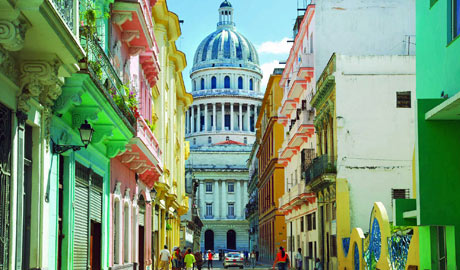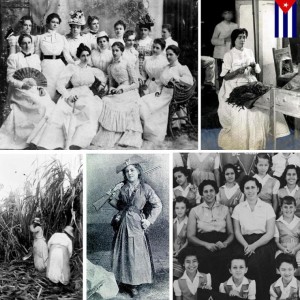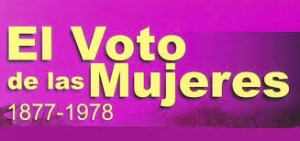LA MUJER EN CUBA – Sus Primeros Logros.
Regresando años dentro de nuestro pasado nacional, Los estudios del siglo XIX cubano y la conformación del idealismo nacionalista han subestimado el discurso femenino presente en más de una veintena de publicaciones periódicas a partir de 1860. En el período 1860-1899 surgen publicaciones femeninas como el “Álbum Cubano de lo Bueno y de lo Bello”, el “Álbum de las Damas”, “Las Hijas de Eva”, “La Mulata”, “Minerva”, etc.
También existen en esta misma época alrededor de 40 colaboradoras con publicaciones oficiales como el “Diario de la Marina”, “El Fígaro”, y con publicaciones independentistas como “El Cubano Libre y Patria”. Un ejemplo fehaciente de la participación de la mujer en el inicio de las guerras de independencia de 1868 se produce en mujeres como Mariana Grajales o Amalia Simoni.
Después de finalizada la primera etapa de la Guerra de Independencia (1868-1878), muchos de los arquetipos construidos para la mujer perdieron sentido. La violencia, el hambre, la emigración, cambiaron la imagen romántica de muchas de las poetizas de las décadas del 50 y 60, donde sobresalió Gertrudis Gómez de Avellaneda, iniciadora de la vanguardia liberal femenina.
En 1870, las ideas de una educación especial para la mujer permitieron una asimilación mucho más rápida de las nociones feministas. Los colegios para “señoritas” -como se les denominaron- permitieron que pedagogas como María Luisa Dolz ganaran en prestigio, ya que incluyó la Segunda Enseñanza, requisito obligatorio para la entrada de mujeres cubanas a la Universidad.
Otro aspecto que influyó en la asimilación del feminismo fue la emigración de miles de mujeres cubanas a los Estados Unidos y las repúblicas latinoamericanas, donde tuvieron que asumir la doble jornada laboral, en la factoría y en el hogar. Por eso no fue sorpresivo encontrar obras poéticas como “El Burgués de la Casa”, de Luz Herrera.
El surgimiento de más de 100 clubes femeninos que simpatizaron con las ideas separatistas de los independentistas cubanos, permitió que las mujeres estuvieran presentes en espacios públicos donde se debatió el futuro de la Isla. El hecho de que las cubanas pudieran presidir un club conformado por sus congéneres y realizar actividades en apoyo a la futura república independiente, creó en ellas una nueva visión de su género.
El siglo XIX marcó el surgimiento de las primeras ideas feministas en Cuba, sobre todo en la década de 1890, la ya citada María Luisa Dolz, autora del discurso femenino más polémico de la década, “Feminismo injusticia de los códigos”, el cual se reflejó en una veintena de publicaciones que incluía los rotativos de mayor difusión del país.
El 21 de febrero de 1901, se aprobó la Constitución, que dejó a las mujeres sin derecho al voto. Este fue el comienzo de una república por la cual también habían luchado las mujeres, quienes no conformes con la visión de sus primeros mandatarios, hicieron reclamos de puestos públicos, sufragio, indemnizaciones y otros tipos de demandas.
En la historia más reciente del siglo XX, el feminismo ha sido un término muy cuestionado. Independiente de cualquier tendencia en otras latitudes, en Cuba permitió la obtención de importantes reivindicaciones en fechas muy tempranas, como la Ley de la Patria Potestad (1917), la Ley del Divorcio (1918) y del Sufragio Femenino (1934).
La construcción de un ideario nacionalista cubano al estilo norteamericano a través de la instrucción pública, utilizó a la fuerza femenina como futura portadora de la pedagogía de su ideal. Esta cuestión se fomentó durante la primera intervención norteamericana en la Isla (1898) y la promoción de “ideas modernas para la mujer”, que incluyó cursos de superación de miles de maestras en la Universidad de Harvard y contactos con el “Woman Club de Boston”. Esos encuentros de seguro influyeron en el ulterior surgimiento de organizaciones feministas al estilo norteamericano en el país.
Existen algunas estadísticas sobre la progresiva incorporación de las mujeres a los recintos universitarios en los primeros 15 años del siglo XIX. En esta etapa 75 mujeres aprobaron los exámenes de oposición a la Universidad y 189 se graduaron de doctoras en diferentes especialidades. De igual forma el magisterio aumentó al número de 4 244, siendo las mujeres el 82% del total de maestros de Cuba.
Las primeras organizaciones del sufragio se fundaron en este mismo período, con un por ciento elevado de maestras y la figura de Amalia Mallén de Oztolaza en la presidencia de las tres primeras: Partido Nacional Feminista (1912), Partido Sufragista (1913), y Partido Nacional Sufragista (1913), agrupaciones que tuvieron el voto como reclamo fundamental
La década del 1910 fue decisiva en los cambios de los arquetipos para la mujer. Por un lado la I Guerra Mundial y su cuestionada “promoción del sector femenino”, y por otro la influencia norteamericana en costumbres, crearon un espectro más amplio para las cubanas, donde los roles domésticos y maritales pudieron empezar a ser variados.
La obtención de la Ley de la Patria Potestad y la Ley del Divorcio, definieron una etapa de auge del feminismo liberal en Cuba que se hará más notorio con la creación del Club Femenino (1918), asociación que nucleó a una parte de las protagonistas del debate feminista de la década del 20.
En 1921 se crean las “Asociaciones Femeninas de Cuba” convocando al Primer Congreso Nacional de Mujeres en 1923, el primero en Hispanoamérica, que incluyó aspectos tan polémicos como la diferencia entre hijos legítimos e ilegítimos, la necesidad de lograr una igualdad entre el hombre y la mujer en la legislación sobre el adulterio y el inevitable tema del sufragio femenino.
Al margen de estos acontecimientos surgieron otros tipos de organizaciones femeninas, como el “Lyceum de La Habana”, con fines culturales y de instrucción; de trabajo como la “Unión Laborista de Mujeres”, y políticas, con posiciones opuestas, como la “Unión Radical de Mujeres” y la tristemente célebre “Porra Femenina”.
Para 1930 el país tenía la cifra de 320 asociaciones femeninas registradas de forma legal. Durante el período de transición del presidente Ramón Grau San Martín, en enero de 1934, fue aprobado el artículo 39 sobre el sufragio femenino. Después del movimiento revolucionario de 1933, se ve reflejado en la celebración en abril de 1939 del “Tercer Congreso Nacional de Mujeres”, donde por primera vez tendrán una amplia representación.
Este evento femenino tuvo repercusión en muchos de los derechos que obtuvo la mujer en la avanzada Constitución de 1940. En el título cuarto, se establece la igualdad independiente de la raza, clase o sexo, y en el título quinto, referente a la familia. En el artículo 43 se otorgó el derecho de la mujer casada a la vida civil sin que necesitase la licencia o autorización marital para regir sus bienes, ejercer libremente el comercio, la industria, profesión o arte y disponer del producto de su trabajo. En el título sexto se planteó que la ley regulaba la protección de la maternidad obrera.
Ya desde 1936 las mujeres participaban en su doble condición de electoras y elegibles. Entre 1936 y 1944, habían alcanzado los siguientes cargos: Alcaldesas 3, Representantes 15, Concejales 2 y Senadoras 2.
Finalizada la década del 40 y comenzando los años 50, el feminismo en Cuba y en muchos lugares del mundo dejó de ser un suceso para convertirse en una realidad inmersa en muchas otras madejas. La II Guerra Mundial había finalizado y con ella la “vuelta a casa para la mujer”. Y las más de 800 asociaciones feministas y femeninas del país se habían ramificado hacia problemáticas diferentes.
Hoy con el mayor esfuerzo como signo de tolerancia activista hacemos llegar nuestras mayores felicitaciones a todas las mujeres de nuestra nacion, para todas, las de antes y las de ahora.
MemoriasDeCuba/Debrunín Jacomé/Editor/InternetPhotos/TheCubanHistory.com
The Cuban History, Hollywood.
Arnoldo Varona, Editor.
CUBA PHOTOS. National Capitol.

THE WOMAN IN CUBA – Its early achievements .
Going back in time, studies of the nineteenth century in Cuba and the formation of the nationalist idealism have underestimated this feminine discourse in more than twenty journals from 1860. In the period from 1860 to 1899 women’s publications emerge as the “Cuban album of Good and the Beautiful, “the” Album of the Ladies “,” Daughters of Eve “,” La Mulata “,” Minerva “, etc.
Also they exist in the same period around 40 collaborating with publications such as “Diario de la Marina”, “Le Figaro” and with independence publications as “El Cubano Libre and Fatherland.” A clear example of the participation of women in the beginning of the wars of independence in 1868 occurs in women as Mariana Grajales or Amalia Simoni.
After completion of the first stage of the War of Independence (1868-1878), many of the archetypes built for the woman lost sense. Violence, hunger, migration, changed the romantic image of many of the poetizas of the 50s and 60s, where he excelled Gertrudis Gómez de Avellaneda, initiator of the female liberal vanguard.
In 1870, the ideas of special education for women allowed a much faster uptake of feminist notions. School for “young ladies”, as they are allowed denominaron- pedagogues like Maria Luisa Dolz win prestige, and which included the Second Education, mandatory requirement for the entry of Cuban women to the University.
Another aspect that influenced the assimilation of feminism was the emigration of thousands of Cuban women in the United States and the Latin American republics, where they had to take on the double workday in the factory and at home. So it was not surprising to find poetic works as “The Bourgeois house” Luz Herrera.
The emergence of more than 100 women’s clubs who sympathized with the separatist ideas of Cuban independence, allowed women to be present in public spaces where the future of the island was discussed. The fact that the Cuban could preside over a club formed by its congeners and activities in support of the future independent republic, created in them a new vision of its kind.
The nineteenth century marked the emergence of the first feminist ideas in Cuba, especially in the 1890s, the aforementioned Maria Luisa Dolz, author of the most controversial female discourse of the decade, “Feminism injustice codes”, which is He reflected in a score of publications including rotary most widespread in the country.
The February 21, 1901, the Constitution, which left women without the right to vote was approved. This was the beginning of a republic which had also fought for women who do not conform to the vision of its first leaders, they made claims for public office, vote, compensation and other demands.
In more recent history of the twentieth century, feminism has been a highly contested term. Independent of any trend elsewhere in Cuba allowed obtaining important demands in a very early date, as the Parental Rights Act (1917), the Divorce Act (1918) and Woman Suffrage (1934).
Building a nationalist ideology Cuban American style through public education, he used the feminine force as future carrier of the pedagogy of his ideal. This question was fostered during the first US intervention in Cuba (1898) and the promotion of “modern ideas for women”, which included upgrading courses of thousands of teachers at Harvard and contacts with the “Woman Club of Boston “. These meetings insurance influenced the subsequent emergence of American-style feminist organizations in the country.
There are some statistics about the progressive incorporation of women to the campus in the first 15 years of the nineteenth century. At this stage, 75 women passed the competitive examination to college and graduated 189 doctors in different specialties. Likewise, the number of teachers rose to 4244, with women 82% of teachers of Cuba.
The first suffrage organizations were founded in the same period with a high percentage of teachers and the figure of Amalia Mallén of Oztolaza as president of the first three: Feminist National Party (1912), Suffragette Party (1913) and Party National Suffragette (1913), groups that took the vote as fundamental demand
The 1910s was instrumental in the changes of the archetypes for women. On the one hand the First World War and questioned “promote women’s sector,” and US influence in other ways, created a broader Cuban, where domestic and marital roles could begin to be varied spectrum.
Obtaining Custody Act and the Divorce Act, defined a boom of liberal feminism in Cuba which will become more noticeable with the creation of the Women’s Club (1918), an association that core part of the stars of feminist debate of the 20s.
In 1921 he created the “Women’s Associations of Cuba” by convening the First National Women’s Congress in 1923, the first in Latin America, which included such controversial as the difference between legitimate and illegitimate children respects the need to achieve equality between men and the women in law on adultery and the inevitable issue of women’s suffrage.
Besides these events other women’s organizations, as the “Lyceum of Havana”, cultural and educational purposes emerged; Working as the “Labor Union Women” and policies, with opposite positions, such as “Radical Women Union” and the infamous “Women Porra”.
By 1930 the country had the figure of 320 registered women’s associations legally. During the transition period of President Ramón Grau San Martin, in January 1934, it was approved Article 39 on women’s suffrage. After the revolutionary movement of 1933, is reflected in the celebration in April 1939 “Third National Congress of Women,” which will have a wide representation for the first time.
The women’s event had an impact on many of the rights that women obtained advanced Constitution quarter 1940. In the title, the independent equality of race, class or sex is established, and the fifth title concerning the family. In Article 43, the right of married women to civilian life without license or marital needed permission to manage property, freely engage in commerce, industry, profession or art and dispose of the product of their work woman was granted. In the sixth title was suggested that the law regulating the protection of the working maternity.
And since 1936 women participated in his dual capacity as electors and eligible. Between 1936 and 1944, they had reached the following positions: three mayors, 15 Representatives, Senators 2 and 2 Councillors.
After the 40s and beginning 50s, feminism in Cuba and in many parts of the world ceased to be an event to become a reality immersed in many other skeins. World War II had ended and with it the “back home to women.” And more than 800 feminists and women’s associations in the country had branched into various problems.
Today with all our effort as a sign of tolerance I extend our greatest congratulations to all the women of our nation, the active Yesterday’s and the one Today’s.
MemoriasDeCuba / Debrunín Jacomé / Editor / InternetPhotos / TheCubanHistory.com
The Cuban History, Hollywood.
Arnoldo Varona, Editor.






